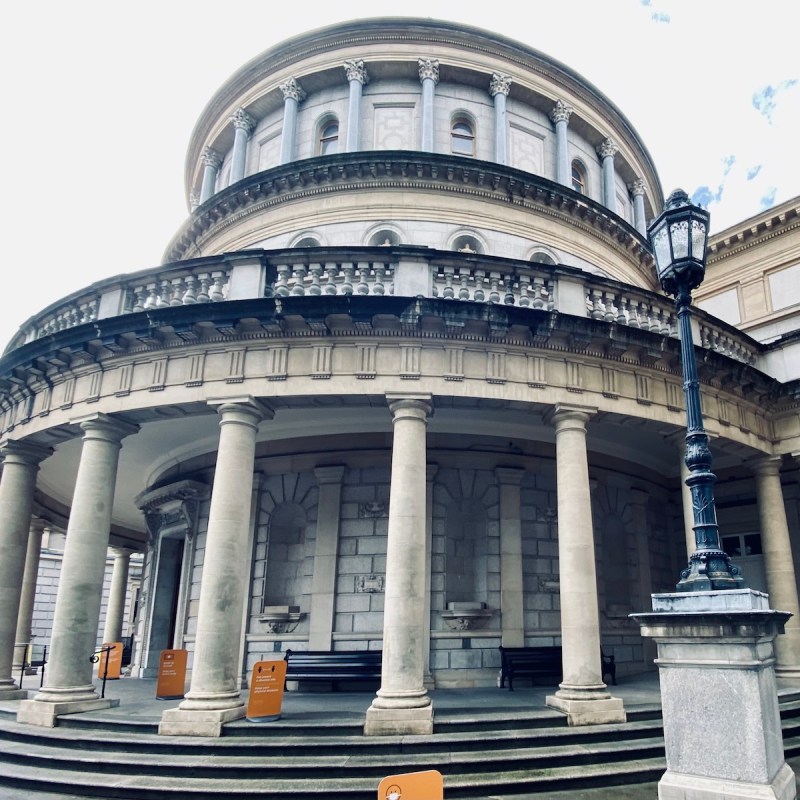
“As if he had been poured / in tar, he lies / on a pillow of turf…” — The Grauballe Man by Seamus Heaney
Videos by TravelAwaits
Dublin, the largest city in Ireland and the capital, has more than 40 museums to entertain, inspire, and shock its visitors. The National Museum of Ireland – Archeology, on Kildare Street, is just across the courtyard from the National Library of Ireland (which has a reading room that rivals the Library of Congress’ Main Reading Room in Washington, D.C.). These two grand and historic buildings are in front of Leinster House, the Seat of the Irish National Parliament. All within blocks of the wall around Trinity College – Dublin. Steeped in history, you can easily imagine yourself falling back in time with nearly 100 years making little difference in this street’s architecture.
It’s especially fitting as Ireland celebrates its centennial in 2022.
The National Museum of Ireland system includes museums that focus on Archeology, Decorative Arts & History, Country Life, and Natural History. These museums host both permanent and rotating exhibits so you’ll never be bored. Fortunately for us, many of them are free, though often require reservations.

What Are Bog Bodies?
When I learned that Halloween originated in Ireland, it was less surprising to learn about the Iron Age phenomenon of bog bodies which I discovered during my last visit to the National Museum of Ireland – Archeology. They seem like a very surreal or spooky part of history that could haunt us forevermore.
Unlike the people found petrified in Pompeii following the Mt. Vesuvius eruption, a bog body has been mummified within a peat bog. Peat was commonly used in Ireland as a source of fuel. Most date from the Iron Age when peat bogs covered a much larger area of Europe. They’ve been found in Ireland, Denmark, Germany, the Netherlands, and the United Kingdom.
When you first enter the exhibit, your brain tries to convince you this must be a sculpture. This shriveled human, curled on his side, arms folded, features the sharp detail of a curled hand, fingernails intact with a small laceration in the right thumbnail — it seems heartbreaking. But they are real.
Bog people have been dated as early as 8000 B.C. and as recently as World War II. By definition, they’ve all been found in peat and at least partially preserved, like the best example, the Cashel man, from 2000 B.C. Clothes, internal organs, and even stomach contents have often been preserved in this unique environment.

How Do Bog Bodies Contribute To Irish Lore? Is It All Blarney?
What leads to the Irish lore is the association with violent death combined with lack of clothing. That’s led archeologists to consider their fate was sealed either by ritualistic killing or execution of criminals.
The variety of reasons for their sentence included being perceived as witches or social outcasts or legal hostages “killed in anger over broken treaty arrangements.”
More recently, the Gundestrup Cauldron, found in Denmark, showed images of Celtic deities on the outside, with panels inside revealing kingship and sovereignty rituals of human sacrifice. A replica can be found in this exhibit.
The exhibit’s information describes hundreds of bog bodies recovered and studied, but believe only about 45 remain intact today.

Human Sacrifice In Ireland
Archeologists now surmise that human sacrifice was a normal part of Celtic rituals. Kings, during hard times, were particularly at risk. If the king failed in his responsibility to ensure the prosperity of his people, he was held personally responsible. This was true even during natural disasters like weather or plague and in war.
Until the middle of the 20th century, it was difficult to tell how long the body had been buried in the bog. Modern forensic technologies allow archeologists to more closely determine the time of death, the victim’s age at burial, and even the last meal. That’s how well peat bogs could preserve these bodies.
Cashel Man, unearthed by workers in 2011, appeared to have been placed on the bog surface. Archeologists determined him to be a young man with wounds that suggest he was a victim of human sacrifice. These sacrifices occurred, based on examination of the bodies recovered, for more than 100 years.

The area where this young man was placed had been a border of a territory containing Crosy Duff Hill where the regional kings of Laois were inaugurated. Other bodies have been placed near important boundaries, as had ceremonial and warfare objects.
This is a primary focus of the National Museum’s exhibit: “based around the theory that human sacrifice and the deposition of the victims in bogs along tribal boundaries is related to sovereignty and kingship rituals during the Iron Age.”
“I can see her drowned / body in the bog, / the weighing stone, / the floating rods and boughs.” — Punishment by Seamus Heaney
And there are so many more exhibits to explore at the National Museum of Ireland – Archeology. Next time you’re in Dublin, be sure to visit!
